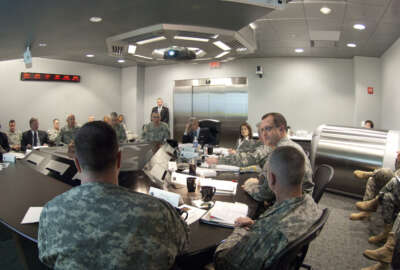
Army will speed up IT modernization on several dozen bases, but most will lag behind
The Army says it will put the lion's share of its enterprise network modernization money toward the 40 to 45 bases it sees as its most important "power projecti...
Best listening experience is on Chrome, Firefox or Safari. Subscribe to Federal Drive’s daily audio interviews on Apple Podcasts or PodcastOne.
The Army has almost 300 bases around the world, and just about all of them are long overdue for IT infrastructure upgrades. But modernizing each of those installations all at once would rack up a bigger bill than the Army’s willing to pay, so officials say it’s time to prioritize.
The Army’s latest approach to network modernization means some of its bases will have their enterprise networks upgraded to the latest and greatest technology over the next four years. But it also means the vast majority of them won’t. The decision was born from Army officials’ belief that it would take 25 to 30 years to complete all the needed IT modernization work if they were to spread their available funding evenly across all 288 posts, camps and stations.
“We’re going to prioritize,” Lt. Gen. Bruce Crawford, the Army’s chief information officer told reporters at the Association of the U.S. Army’s annual conference in Washington. “The Army does several things well, and that’s one of them. The most important power projection platforms for the Army are where we’re going to start to — I won’t say funnel — but pass most of our resources to modernize between now and 2024.”
The Army hasn’t yet finished tallying its list of higher-priority bases, but Crawford said it’s likely to be made up of between 40 and 45 installations worldwide. Officials will compile the list under the framework of what senior officials are calling “strategic readiness” — essentially favoring the bases they deem to be most critical to deploying and supporting large numbers of forces around the world.
“Think of the major systems that allow us to project power forward around the world. Are those systems ready? The network is also a big piece of that,” he said. “So rather than trying to do everything everywhere, we did a risk assessment of all 288 bases. Some of it is going to be in the institutional Army — it might be a center of excellence. Think about our combat training centers. Think about where our 10 divisions are. Think about projecting power when it comes to our National Guard and Army Reserve. So it’s not just active Army, but total Army.”
Crawford said the bases that don’t make their way onto the prioritized list will most likely see their networks gradually modernized at roughly the same pace they’re experiencing right now — in other words, fairly slowly. The service currently estimates 70% of the servers, routers and end-user devices on its installations are at or near the end of life. The same is true for 90% of its voice communications infrastructure.
Related Stories

Army, DHA take steps to stop managing day-to-day IT operations
Last month, the Army awarded contracts to Verizon, AT&T and Microsoft to begin piloting the enterprise IT-as-a-service (EITaaS) approach to network modernization. They will test the privatized networks at nine large, medium and small bases over the next several years.
But officials emphasize the effort to prioritize bases for IT upgrades and the EITaaS are not one and the same. EITAAS is still just a pilot, but the Army hopes to learn a lot from it, said Lt. Gen. Stephen Fogarty, the commander of Army Cyber Command.
“As we looked at the places we’re testing, each one presents a different challenge,” he said. “And at the end of this, we’ll have to make some decisions. First of all, did it work? What were the things that are going to need to be changed technically? What are the things that are going to allow us to scale it across the Army or even a portion of the Army? We’ve awarded the contract and now the really hard work starts to begin. The good thing is we’ve got the Air Force also looking at nine different locations, and using similar processes, and we’re going to compare notes.”
One reason the Army sees potential value in involving private industry more heavily in its on-base IT networks is that the technologies that make up those systems are, for the most part, inherently commercial. As of now, Army personnel are being used to operate and maintain those systems, and the Army would rather put that manpower toward higher-end, military-specific systems.
Latest Defense News
And the IT upgrades aren’t just about boosting the bandwidth available on military bases or improving office systems like email and printing. The Army says the quality and capabilities of its installation networks are increasingly going to be non-negotiable requirements for just about everything it does.
“All the things we talk about – whether it’s a suite of sensors or a training platform, things that enable a vehicle to move around, those are going require some kind of 5G backbone, some kind of robust network to make them work,” said Jordan Gillis, the principal deputy assistant secretary of the Army for installations, energy and environment. “So we’re looking to be sure that we have the right policy. We need to designate that as a mission requirement, as opposed to 25 years ago when we envisioned this as all WiFi and personal cell phones. It’s not any more. It’s mission requirement, it’s a business requirement. We need to recognize it as such.”
Copyright © 2024 Federal News Network. All rights reserved. This website is not intended for users located within the European Economic Area.
Jared Serbu is deputy editor of Federal News Network and reports on the Defense Department’s contracting, legislative, workforce and IT issues.
Follow @jserbuWFED







